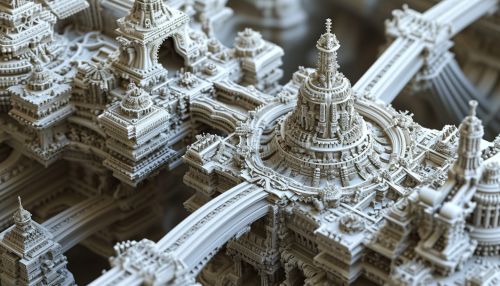3D modeling
Introduction
3D modeling is the process of creating a three-dimensional representation of any surface or object by manipulating polygons, edges, and vertices in simulated 3D space. The product is called a 3D model. It can be displayed as a two-dimensional image through a process called 3D rendering or used in a computer simulation of physical phenomena. The model can also be physically created using 3D printing devices.


History
The history of 3D modeling dates back to the 1960s when the need to visualize the geometric data in three dimensions arose. The first 3D wireframe model was created by Ivan Sutherland in 1963. His software, known as Sketchpad, was an innovative system developed for the TX-2 computer at MIT. The system was capable of creating, manipulating, and displaying basic wireframe models. It was a major development in the field of computer graphics, and laid the foundation for the development of 3D modeling.
Types of 3D Models
There are two major types of 3D models: solid and shell/boundary.
Solid Models
Solid models represent a solid mass of an object. They are more realistic, but more complex to create. They are mostly used in engineering and medical simulations, and for 3D printing.
Shell/Boundary Models
Shell/Boundary models represent the surface, not the volume, of an object. These models are easier to work with and these are the type of models that are used in video games and films.
3D Modeling Techniques
There are several techniques that 3D artists use to create models. These techniques can be broadly classified into two categories: Procedural and Interactive.
Procedural Techniques
Procedural techniques use algorithms and equations to create models. These techniques include constructive solid geometry, curve modeling, and volume modeling.
Constructive Solid Geometry
Constructive Solid Geometry (CSG) is a modeling technique that uses Boolean operations like union, intersection, and difference to combine 3D solids. This technique is often used in CAD applications.
Curve Modeling
Curve modeling is a technique that uses curves to create the surface of the model. The curves are defined by mathematical equations, which make it easier to manipulate them.
Volume Modeling
Volume modeling is a technique that uses 3D volumetric pixels (voxels) to create models. This technique is often used in medical imaging and games.
Interactive Techniques =
Interactive techniques allow artists to create models by manipulating them directly. These techniques include box modeling, polygonal modeling, and digital sculpting.
Box Modeling
Box modeling is a technique that starts with a geometric primitive (like a box, cylinder, sphere, etc.) and refines it into a detailed model by splitting, extruding, and manipulating its faces.
Polygonal Modeling
Polygonal modeling is a technique that uses polygons to create models. This technique is widely used in the industry because it is flexible and can create models quickly.
Digital Sculpting
Digital Sculpting is a technique that allows artists to push, pull, smooth, grab, pinch or otherwise manipulate a digital object as if it were made of a real-life substance such as clay.
3D Modeling Software
There is a wide range of 3D modeling software available, each with its own strengths and weaknesses. Some of the most popular ones include Blender, Maya, 3ds Max, and ZBrush. These software tools offer a variety of features that can be used to create complex and detailed 3D models.
Applications of 3D Modeling
3D modeling has a wide range of applications in various fields. It is used in industries like film, animation, gaming, architecture, engineering, and medical science.
Film and Animation
In film and animation, 3D models are used to create characters and environments. These models are then animated and rendered to create the final scene.
Gaming
In the gaming industry, 3D models are used to create everything from characters to environments. These models are then used in real-time game engines like Unity and Unreal Engine.
Architecture
In architecture, 3D models are used to create a visual representation of buildings before they are built. This allows architects and clients to visualize the final product, and make changes before construction begins.
Engineering
In engineering, 3D models are used to create detailed representations of mechanical parts. These models can then be used in simulations to test the performance of the part.
Medical Science
In medical science, 3D models are used to create detailed representations of organs. These models can then be used for study, or to plan surgeries.
